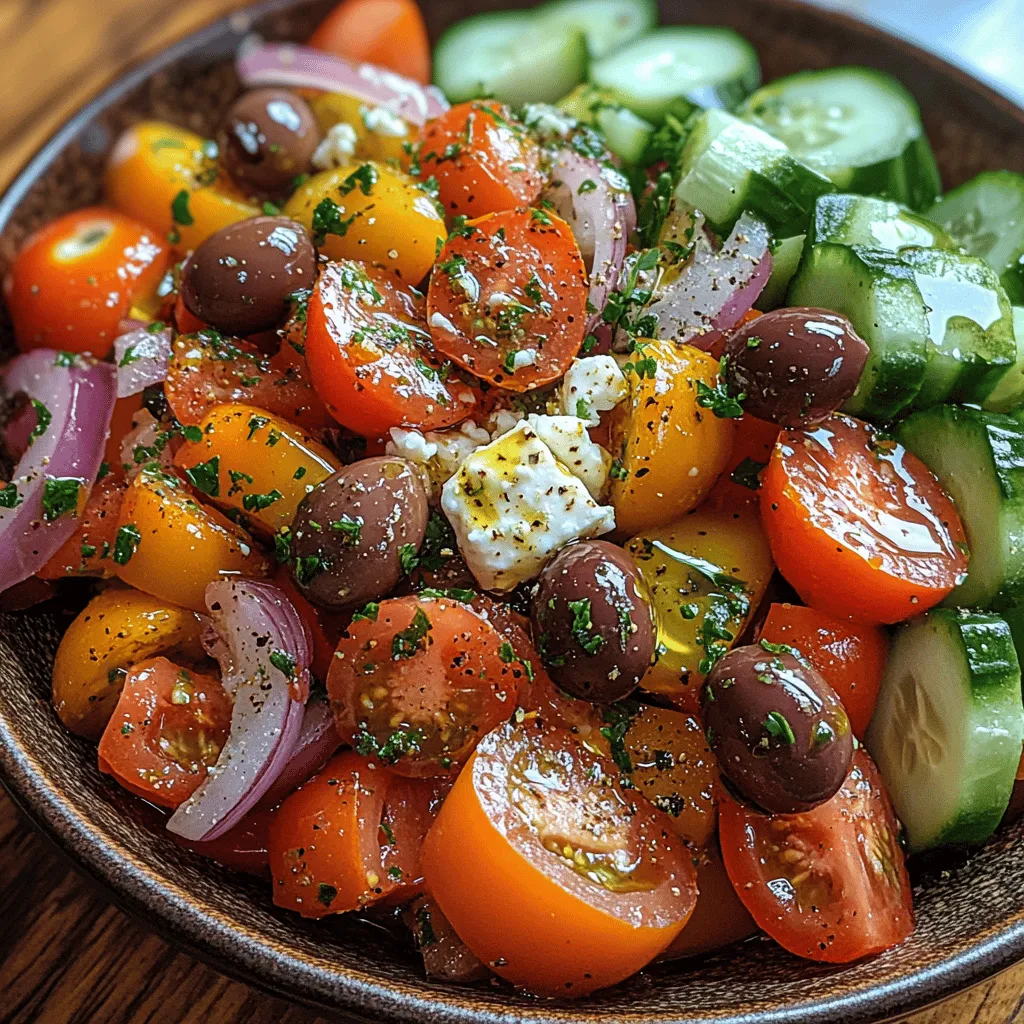Introduction
Greek salad, or “Horiatiki,” is a traditional dish that beautifully encapsulates the essence of Mediterranean cuisine. Hailing from the sun-drenched shores of Greece, this vibrant salad is more than just a delightful mix of fresh ingredients; it represents a rich cultural heritage steeped in history and tradition. In many Greek households, this salad is a staple at every meal, celebrated not only for its refreshing taste but also for its ability to bring people together.
The foundation of Greek salad lies in its fresh, wholesome ingredients that are emblematic of the Mediterranean diet, which is renowned for promoting health and longevity. Packed with colorful vegetables, healthy fats, and protein, Greek salad offers a multitude of health benefits, including improved heart health, enhanced digestion, and increased energy levels. The Mediterranean diet emphasizes the use of fresh, seasonal produce, making Greek salad an ideal choice for those seeking a nutritious and satisfying meal.
One of the most appealing aspects of this dish is its simplicity. With minimal preparation and a handful of ingredients, you can create a flavorful and visually stunning salad that is perfect for any occasion. Whether served as a refreshing side dish during a summer barbecue or as a light main course, Greek salad is a versatile culinary masterpiece that showcases the best of Mediterranean flavors.
Understanding the Ingredients
To truly appreciate the allure of Greek salad, it is essential to understand the role of each ingredient that contributes to its unique flavor profile and health benefits.
Ripe Tomatoes
At the heart of Greek salad lies the juicy and vibrant ripe tomato. These succulent fruits are not only packed with flavor but also loaded with essential nutrients. Rich in vitamins C and K, potassium, and antioxidants such as lycopene, tomatoes can contribute to heart health and reduce inflammation. When selecting tomatoes for your salad, opt for the freshest, ripest varieties available, as their flavor will significantly enhance the overall taste of the dish.
Cucumber
The cucumber is another crucial component of Greek salad, providing a refreshing crunch and a hydrating element. With a high water content, cucumbers help to keep the body hydrated, making them an excellent addition to any summer meal. Nutritionally, cucumbers are low in calories and rich in vitamins A and K, as well as various minerals. For the best texture, choose firm cucumbers and slice them into bite-sized pieces to create a pleasing contrast with the other ingredients.
Red Onion
Adding a touch of sweetness and a delightful crunch, red onions play a vital role in elevating the flavors of Greek salad. Their vibrant color adds visual appeal, while their robust taste complements the other ingredients beautifully. Red onions are also known for their health benefits, which include being high in antioxidants and promoting heart health. When preparing the onions, consider thinly slicing them and soaking them in cold water for a few minutes to mellow their intensity.
Bell Pepper
Bell peppers contribute not only a burst of color but also a sweet and slightly tangy flavor to the salad. Rich in vitamins A and C, as well as antioxidants, bell peppers are a powerhouse of nutrition. The crunchiness of the bell pepper adds yet another layer of texture, enhancing the salad’s overall appeal. For a classic Greek salad, opt for red or yellow bell peppers, which provide a lovely contrast against the other ingredients.
Kalamata Olives
No Greek salad would be complete without the addition of Kalamata olives. Known for their distinctive flavor and deep purple hue, these olives add a briny richness that balances the freshness of the vegetables. Kalamata olives are also rich in healthy monounsaturated fats, antioxidants, and anti-inflammatory compounds. When selecting olives for your salad, look for high-quality, pitted Kalamata olives to ensure a convenient and enjoyable eating experience.
Feta Cheese
Feta cheese is arguably the star ingredient of Greek salad, providing a creamy, tangy contrast to the crisp vegetables. This traditional cheese is made from sheep’s milk or a mixture of sheep and goat’s milk, giving it a unique flavor and crumbly texture. Various types of feta exist, with some being saltier or creamier than others. When crumbled over the salad, feta adds a rich depth that ties all the flavors together, making it an indispensable component of this dish.
Extra Virgin Olive Oil
A hallmark of Mediterranean cuisine, extra virgin olive oil is not only crucial for flavor but also for its numerous health benefits. Rich in heart-healthy monounsaturated fats and antioxidants, extra virgin olive oil has been linked to reduced risks of chronic diseases. It acts as a dressing base that enhances the flavors of the salad while providing a smooth, velvety texture. When selecting olive oil, choose high-quality extra virgin varieties for the best taste and health benefits.
Red Wine Vinegar
Red wine vinegar serves as an essential flavor enhancer in Greek salad, providing a tangy acidity that brightens the dish. It balances the richness of the feta cheese and olive oil, creating a harmonious blend of flavors. Additionally, red wine vinegar contains beneficial compounds that may aid in digestion and enhance heart health. A splash of this vinegar will elevate the overall taste of the salad, making it a must-have ingredient.
Dried Oregano
Dried oregano brings a fragrant aroma and earthy flavor to Greek salad, tying together the fresh ingredients with its herbal notes. Oregano is a staple herb in Mediterranean cooking, known for its antioxidant properties and potential health benefits, including anti-inflammatory effects. A sprinkle of dried oregano over the salad will not only enhance its flavor but also add a touch of authenticity to the dish.
Fresh Parsley
Finally, fresh parsley serves as a vibrant garnish that adds a pop of color and a hint of freshness to the salad. This herb is also rich in vitamins A and C and contains antioxidants that can support overall health. When using fresh parsley, be sure to chop it finely to distribute its flavor throughout the salad.
Step-by-Step Instructions for Preparation
Now that we have explored the incredible ingredients that make up this Mediterranean delight, it’s time to delve into the step-by-step instructions for preparing Greek salad. This comprehensive guide will ensure you create a stunning and delicious dish that highlights the fresh flavors of the Mediterranean.
Preparing the Vegetables
1. Wash and Dry: Begin by thoroughly washing all your vegetables under cold running water. This step is crucial for removing any dirt or pesticides. After rinsing, gently pat them dry with a clean kitchen towel.
2. Chop the Tomatoes: Using a sharp knife, cut the ripe tomatoes into bite-sized wedges or chunks. If your tomatoes are particularly juicy, you may want to remove some of the seeds to prevent excess moisture in the salad.
3. Slice the Cucumber: Choose whether to peel the cucumber or leave the skin on for added texture and nutrients. Cut the cucumber in half lengthwise and then slice it into half-moons or quarter rounds, depending on your preference.
4. Prepare the Red Onion: Thinly slice the red onion into rings or half-moons, aiming for uniformity in thickness for even flavor distribution. If desired, soak the slices in a bowl of cold water for 10-15 minutes to reduce their sharpness.
5. Chop the Bell Pepper: Remove the stem and seeds from the bell pepper, then slice it into thin strips or bite-sized pieces. This addition will add a delightful crunch and vibrant color to your salad.
Incorporating Olives
When it comes to Kalamata olives, quality matters. To ensure you select the best olives for your Greek salad, consider the following tips:
1. Choose Quality Olives: Look for pitted Kalamata olives that are packed in brine or olive oil. Avoid those that are overly salty or processed, as they may detract from the overall flavor of your salad.
2. Rinse and Drain: Before adding the olives to your salad, rinse them under cold water to remove excess brine. Drain well and set aside.
Crumbling Feta
Crumbling feta cheese can be a delicate process, but with the right technique, you can achieve the perfect texture:
1. Select Your Feta: If possible, choose a block of feta cheese rather than pre-crumbled varieties. This will allow you to control the texture and freshness.
2. Crumble with Care: Using your fingers or a fork, gently crumble the feta into small pieces over the salad. Aim for a mix of larger and smaller crumbles to create a visually appealing presentation.
Making the Dressing
Creating a well-balanced dressing is key to enhancing the flavors of your Greek salad. Follow these steps to prepare the perfect dressing:
1. Combine Ingredients: In a small bowl, whisk together extra virgin olive oil, red wine vinegar, and a pinch of dried oregano. For added depth, you can include a teaspoon of Dijon mustard or minced garlic, depending on your taste preferences.
2. Season to Taste: Taste the dressing and adjust the seasoning as needed. A pinch of salt and freshly cracked black pepper can elevate the flavor profile.
Dressing the Salad
Finally, it’s time to bring your Greek salad together:
1. Combine All Ingredients: In a large mixing bowl, combine the chopped tomatoes, cucumber, red onion, bell pepper, Kalamata olives, and crumbled feta cheese. Gently toss the ingredients to ensure an even distribution.
2. Add the Dressing: Drizzle the prepared dressing over the salad, being careful not to drown the ingredients. The goal is to lightly coat each component for maximum flavor without overwhelming the salad.
3. Toss Gently: Using a large spoon or spatula, gently toss the salad to combine all the ingredients and dressing. Be cautious not to break up the feta cheese too much, as you want to maintain its texture.
4. Garnish with Fresh Parsley: Finally, sprinkle the finely chopped fresh parsley over the top of the salad for a touch of color and freshness.
With these steps completed, your Mediterranean Bliss Greek Salad is now ready to be served and enjoyed! The combination of fresh, vibrant ingredients and the harmonious dressing will tantalize your taste buds and leave you craving more. Whether enjoyed on its own or as a delightful accompaniment to grilled meats or pita bread, this salad embodies the essence of Mediterranean cuisine.
Garnishing: The Role of Presentation in Enjoying the Meal
When it comes to enjoying a meal, presentation plays a crucial role. A beautifully garnished dish not only pleases the eye but also enhances the overall dining experience. For the Mediterranean Bliss Greek Salad, consider using fresh herbs as a finishing touch. A sprinkle of freshly chopped parsley or a few mint leaves can add a pop of color and freshness. Additionally, drizzling a little extra virgin olive oil or a balsamic reduction over the top can elevate the visual appeal and add depth to the flavors.
The arrangement of the ingredients also matters. Layering the salad in a large, shallow bowl allows the vibrant colors of the tomatoes, cucumbers, and bell peppers to shine through, creating an inviting presentation. A well-garnished salad not only entices the palate but also sets the stage for a delightful meal.
The Art of Flavor Combination
The Mediterranean Bliss Greek Salad is a harmonious blend of flavors and textures, each ingredient playing a vital role in the overall experience. The refreshing crunch of cucumbers and bell peppers complements the juicy sweetness of ripe tomatoes, creating a delightful contrast. The addition of red onions brings a sharpness that cuts through the richness of the feta cheese, while the black olives provide a briny depth that enhances the salad’s complexity.
The balance of acidity from the red wine vinegar is key to this salad’s success. It brightens the flavors, adding a tangy note that cuts through the creaminess of the feta. The creamy texture of the feta cheese not only adds richness but also serves as a perfect counterpoint to the crunchy vegetables. Together, these components create a symphony of flavors that dance on the palate.
Fresh herbs, such as oregano and dill, play a significant role in elevating the flavor profile of the salad. Oregano, in particular, is a staple in Mediterranean cuisine, providing an earthy and aromatic quality that complements the other ingredients beautifully. The use of fresh herbs not only enhances the taste but also adds a burst of freshness that ties the dish together.
Nutritional Benefits of Mediterranean Bliss Greek Salad
Incorporating the Mediterranean Bliss Greek Salad into your diet offers numerous health benefits, making it a perfect choice for those seeking a balanced and nutritious meal. The Mediterranean diet, recognized for its health-promoting properties, emphasizes the consumption of fresh vegetables, healthy fats, whole grains, and lean proteins. This salad embodies these principles.
The vegetables in the Greek salad are packed with antioxidants, vitamins, and minerals. Tomatoes are rich in lycopene, known for its potential heart health benefits; cucumbers provide hydration and a low-calorie crunch; and bell peppers are high in vitamin C, which supports the immune system. Moreover, the healthy fats from extra virgin olive oil contribute to heart health and reduce inflammation.
A nutritional breakdown of the Mediterranean Bliss Greek Salad reveals that a typical serving contains approximately 200 calories, with healthy fats originating from olive oil and feta cheese. The salad provides around 8 grams of protein, primarily from the feta and olives, along with essential vitamins such as vitamin A, vitamin C, and vitamin K. By focusing on fresh ingredients, this Greek salad not only satisfies the taste buds but also promotes a healthy lifestyle.
Serving Suggestions and Pairing Ideas
The versatility of the Mediterranean Bliss Greek Salad makes it suitable for various occasions. Whether enjoyed as a light lunch, a vibrant side dish at a barbecue, or a refreshing appetizer before a main course, this salad can fit seamlessly into any meal plan.
For a heartier option, consider pairing the salad with grilled chicken or fish. The lightness of the salad complements the savory flavors of grilled proteins, creating a balanced and satisfying meal. Alternatively, it can be served alongside other Mediterranean dishes, such as hummus, tzatziki, or stuffed grape leaves, to create a delightful mezze platter.
When it comes to beverages, a crisp white wine, such as Sauvignon Blanc or Pinot Grigio, pairs beautifully with the flavors of the Greek salad. For those preferring non-alcoholic options, a sparkling water infused with lemon or a refreshing iced tea can enhance the meal experience.
Storing and Meal Prep Tips
To enjoy the Mediterranean Bliss Greek Salad throughout the week, proper storage and meal prep techniques are essential. If you have leftovers, store them in an airtight container in the refrigerator. The salad is best consumed within 2-3 days for optimal freshness and flavor. If possible, keep the dressing separate until you’re ready to serve to prevent the vegetables from becoming soggy.
For meal prep, consider chopping vegetables in advance and storing them in individual containers. This allows for quick assembly when you’re ready to enjoy a fresh salad. You can also prepare the dressing ahead of time and store it in the refrigerator for up to a week. When ready to serve, simply combine the prepared ingredients and dressing for a quick, healthy meal.
Conclusion
The Mediterranean Bliss Greek Salad is a celebration of vibrant flavors and health benefits, making it a perfect addition to any meal plan. With its refreshing combination of fresh vegetables, creamy feta, and zesty dressing, this salad embodies the essence of Mediterranean cuisine.
Incorporating this dish into your regular meals not only enhances your culinary repertoire but also promotes a healthy lifestyle rich in nutrients. Emphasizing the importance of fresh ingredients, this salad serves as a reminder that cooking can be both enjoyable and nutritious. So, gather your ingredients, enjoy the process of making this delightful salad, and savor the vibrant flavors that the Mediterranean has to offer.


